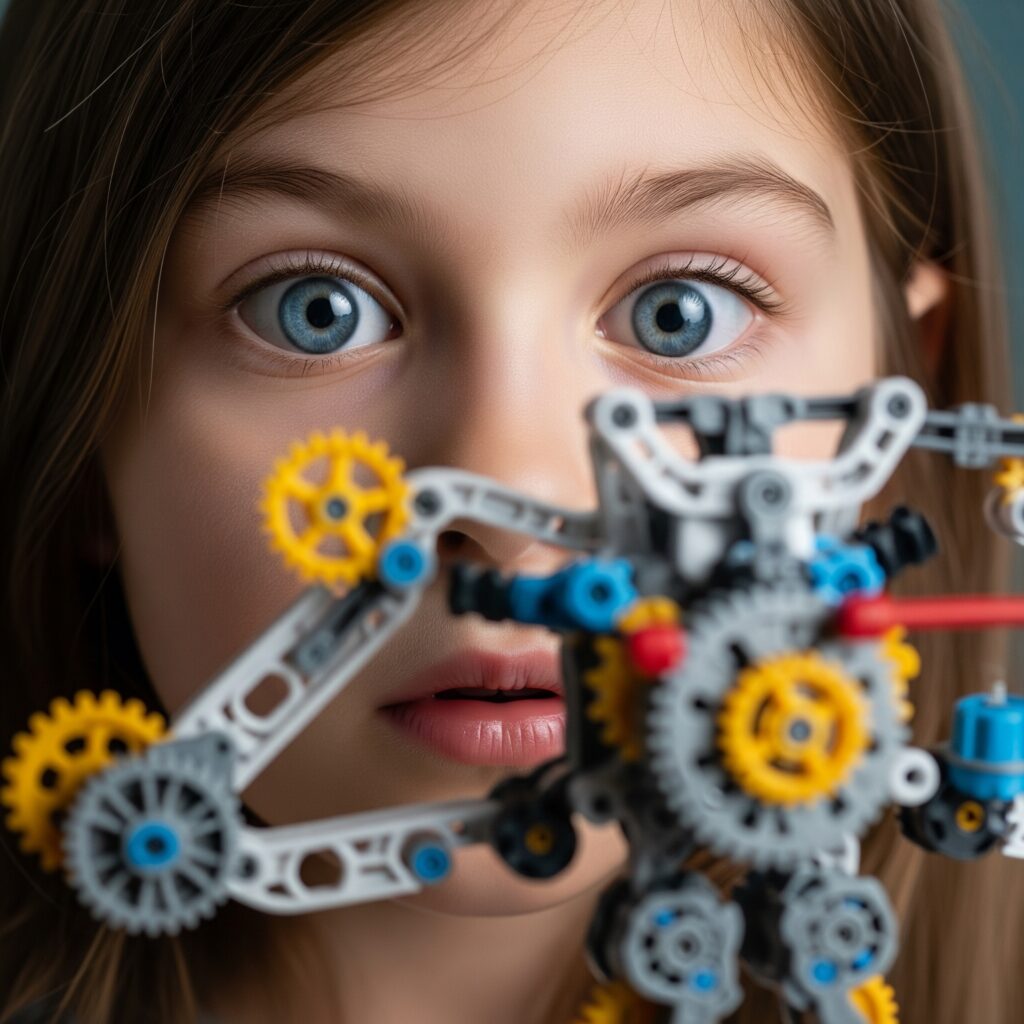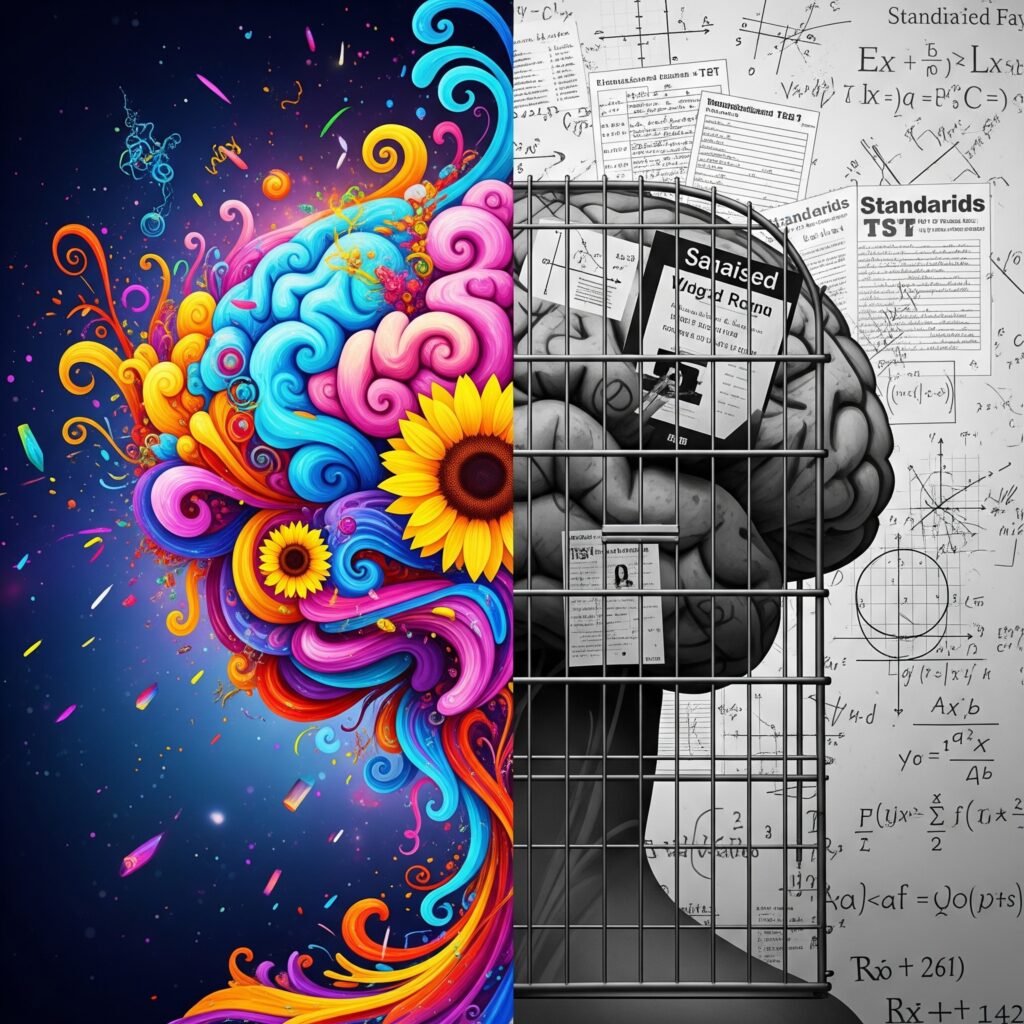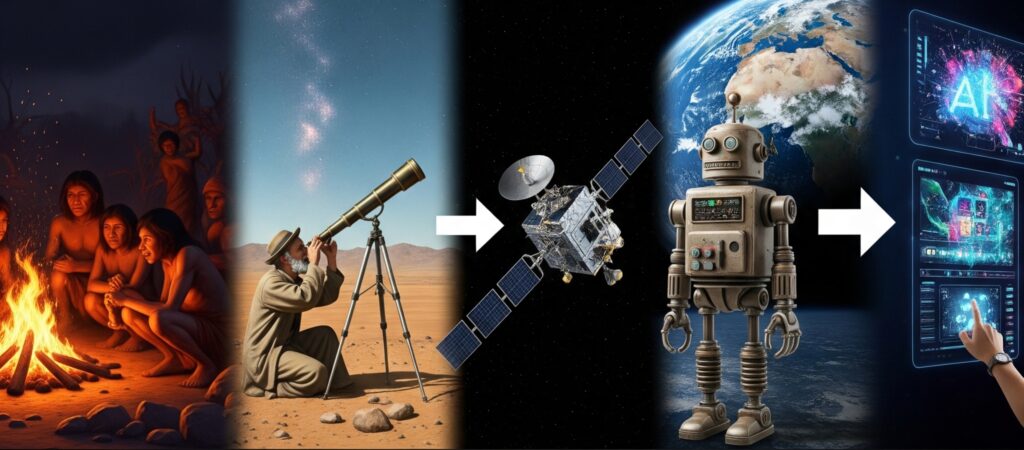When Did We Stop Asking "Why?": The Lost Art of Curiosity
Remember being a child, the relentless ‘Why?’ on your lips, driven by an innate curiosity to understand the world? This fundamental human trait, essential for innovation and human progress, often diminishes as we navigate the education system and societal pressures. We’re taught to conform, trading genuine inquiry for prescribed answers, leading to a quiet erosion of our natural drive to keep asking ‘why’.
It’s a curious paradox, isn’t it? We are born as tiny scientists, driven by an inherent need to explore and comprehend our world. This profound drive manifests as babies engage with their environment through all their senses, actively exploring their impact on objects and people. Children consistently demonstrate “increased interest in situations with high degrees of uncertainty,” preferentially playing with toys whose underlying mechanisms are not yet understood. This intrinsic motivation for discovery is a cornerstone of early learning, effectively placing children “at the centre of their learning”.
Yet, as we progress through structured education systems and navigate the pressures of adult society, something shifts. We are taught to follow, to conform, to be educated into boxes. Modern teaching tools and strategies are frequently observed to “ignore–or subvert–this incredible curiosity”. The focus often moves from discovery to delivery, from asking profound questions to providing prescribed answers.
The result? A quiet erosion of our natural curiosity. We memorize facts without always understanding the underlying principles. We adopt processes without questioning their efficiency or origin. We accept narratives without digging into their nuances. The vibrant, open playground of a child’s mind can slowly become a fenced-in, manicured garden of ‘known facts,’ leaving little room for spontaneous exploration or the thrill of genuine inquiry.

The Curious Paradox: How Society Unwittingly Stifles Our Innate Drive
While babies are unequivocally “born curious” , there is a documented “general decline in curiosity” beyond the early years. This decline is attributed, in part, to children having “fewer opportunities to be curious as they progress through primary and secondary education”. This creates a critical tension: a powerful, innate human drive appears to be suppressed by systemic factors rather than naturally diminishing with age.
The conventional education system, despite its noble intentions, often inadvertently suppresses one of humanity’s most valuable traits: curiosity. This suppression can lead to a significant disconnect between students’ inherent potential and their actual abilities as future entrepreneurs and innovators. Several key factors within traditional educational structures contribute to this suppression:
- Standardized Testing: Many systems heavily rely on standardized tests, which tend to emphasize “rote memorization and regurgitation of facts”. This approach often discourages critical thinking or creative problem-solving, as students are disincentivized from exploring topics in depth or asking questions that extend beyond the testable material.
- One-Size-Fits-All Curriculum: Curricula are typically designed to cater to a broad range of students, which means they may not align with individual students’ diverse interests or passions. This can result in disengagement and a diminished sense of curiosity.
- Fear of Failure: Traditional education often penalizes mistakes and failures. Students are frequently discouraged from taking intellectual risks or pursuing unconventional ideas, as these actions might lead to lower grades or criticism. This pervasive fear of failure can severely inhibit curiosity and the experimentation essential for innovation.
- Emphasis on Right Answers: In many classrooms, there is a strong focus on identifying the single “right” answer to a problem. This discourages students from exploring multiple perspectives or thinking creatively outside conventional boundaries, a mindset crucial for entrepreneurs and innovators who must challenge existing wisdom and embrace ambiguity.
- Lack of Real-World Application: Theoretical knowledge is often prioritized over practical skills and real-world application. This can leave students feeling disconnected from the practical relevance of what they are learning, hindering their ability to see how their knowledge can be used to solve tangible problems.
- Limited Autonomy: Students typically have limited autonomy in traditional educational settings. They are told what to learn, when to learn it, and how to learn it. This can stifle their ability to explore their own interests, pursue independent projects, or follow their curiosity.
This critical examination reveals how traditional educational structures, despite their stated goals, frequently work against the natural human inclination towards curiosity, leading to negative consequences for student engagement and future capabilities.

The Evolutionary Engine: Why Curiosity is Humanity’s True Superpower
Yet, if you look at the individuals who have truly moved the needle – the visionaries, the innovators, the game-changers – they share one undeniable trait: an almost obsessive curiosity. Curiosity serves as the fundamental “driving force behind innovation, critical thinking, and entrepreneurial success”.
From Albert Einstein’s profound emphasis on “not to stop questioning” and cultivating a sense of “awe when one contemplates the mysteries of eternity, of life, of the marvelous structure of reality” , to Steve Jobs’s conviction that “Creativity is just connecting things” and his belief that customers often don’t know what they want until it’s shown to them , these leaders embody the power of inquiry. Jobs famously referenced Henry Ford’s “faster horse” analogy, underscoring the need to anticipate needs rather than just reacting to them. He also advised, “Sometimes when you innovate, you make mistakes. It is best to admit them quickly and get on with improving your other innovations”. Elon Musk champions a mindset of questioning assumptions, rectifying errors, and adapting to reality. He directly linked innovation to a willingness to embrace failure, stating, “If things are not failing, you are not innovating enough”.
This isn’t a new phenomenon; it’s the very heartbeat of human progress. Consider how curiosity has propelled us through the ages:
- From Primal Fear to Controlled Power: Imagine our ancestors, terrified by lightning-struck trees, the acrid smoke stinging their primitive eyes. It was raw terror. But then, driven by a spark of ‘why’ – Why does it burn? How can we control it? – they moved from fear to fascination, harnessing fire for warmth, cooking, and protection. That leap, from terrified avoidance to controlled mastery, was pure, unadulterated curiosity in action. The control of fire, appearing almost two million years ago, led to profound changes in human behavior, health, energy expenditure, and geographic expansion, enabling survival in colder climates and deterring predators. It revolutionized food habits, tool manufacturing (like heat-treated silcrete blades around 164,000 years ago), and even contributed to the development of language through increased social interaction around hearths.
- From Divine Whim to Predictable Patterns: For millennia, phenomena like weather were attributed to the thunderous pronouncements of gods on Olympus, echoing in ancient minds. The inexplicable was divine. But the relentless questioning, the methodical observation of the skies, the tireless pursuit of patterns, transformed this belief. The scientific study of meteorology dates back to ancient Indian writings (3000 BC) and Babylonian observations (650 BC). This continuous pursuit led to crucial technological advancements: early hygrometers (206 BC), compasses (200 BC), windsocks (100 BC), the first standardized rain gauge (1441), mechanical anemometers (1450), and the revolutionary thermometers (early 17th century) and barometers (1643). We now predict weather with incredible precision, thanks to the quiet hum of meteorological satellites (like TIROS-1 in 1954) and complex computer models – all born from a profound need to understand how the world works, not just that it does.
- From Sci-Fi Dream to Tangible Reality: Think about the shimmering, almost magical interfaces of artificial intelligence depicted in science fiction movies like Metropolis (1927) or Isaac Asimov’s I Robot (1950) or any of Marvel’s movies. For decades, it was pure fantasy. Yet, a legion of minds, driven by an insatiable ‘what if?’ and a relentless ‘how can we build this?’, chipped away at the impossible. The foundational idea of artificial neural networks emerged in 1943 , and the term “Artificial Intelligence” was coined in 1956. Key milestones like Claude Shannon’s Theseus robotic mouse (1950) , Frank Rosenblatt’s Perceptron (1958) , the ELIZA chatbot (1966) , IBM’s Deep Blue defeating a chess champion (1997) , and the breakthroughs in image recognition with AlexNet (2012) paved the way. Today, the cold, hard logic humming within our data centers, exemplified by OpenAI’s GPT models (2019-2022) , is bringing AI to life, assisting us daily in ways once unimaginable. This wasn’t achieved by accepting the limits of what was; it was achieved by constantly pushing the boundaries of what could be.
Curiosity, in essence, is a form of intellectual rebellion. It’s the quiet defiance against complacency, the persistent itch to peel back another layer, to ask one more question. It’s the engine that has fueled every scientific breakthrough, every artistic masterpiece, every societal advancement.

Reclaiming Your “Why”: How to Rekindle the Spark of Inquiry
So, how do we reclaim this superpower in a world that often trains it out of us? It starts with a simple, yet profound shift: embracing the power of not knowing. Being truly curious means being comfortable with uncertainty, seeing a blank space not as a void, but as an invitation to explore.
Curiosity isn’t a gift reserved for geniuses; it’s a muscle that anyone can develop. And the beauty is, it doesn’t require grand scientific expeditions. You can start small. Educators, Team Leader or Project Managers, for instance, can powerfully leverage students’ innate desire to learn for deeper classroom engagement. This necessitates a shift from rigid, linear teaching methodologies towards a “richer, more experiential way of learning”.
Here are some practical, evidence-based approaches to cultivate curiosity, applicable in various contexts:
- Introduce Knowledge Gaps: Highlight what learners do not yet know to create a state of uncertainty that naturally prompts inquiry. For example, in a financial literacy course, you might start by saying, “Most people think they have a good handle on their finances, but did you know that most people in this country retire with less than $10,000 in savings?”.
- Leverage the Unexpected: Present surprising or counterintuitive facts or scenarios to challenge existing knowledge. Progressively introduce complexities to create “prediction errors” that drive deeper investigation.
Promote Choice and Autonomy: Allow individuals to determine their own learning paths and methods. In education, “Choice Boards” or “Learning Menus” can increase student ownership. In professional settings, this might involve allowing employees to take on new roles or broaden their networks. - Encourage Explanation and Construction of Understanding: Ask individuals to articulate their thinking in creative ways, such as designing a mascot to represent a concept and explaining its symbolism. For adults, reflection activities like journaling or discussion groups can help process new information.
- Shift Cognitive Load: Encourage individuals to invest in their own learning. Students can record or create lessons to teach content to others.
- Focus on High-Interest Topics: Content that aligns with personal interests has been shown to improve and sustain attention and effort. Identify interests through surveys or observing engagement with optional training.
- Utilize Desirable Difficulties: These are learning experiences that demand reflective effort, posing short-term challenges but yielding long-term benefits. Assessments should be designed to reward exploration rather than merely correct answers.
- Encourage Question-Asking: Leaders should model curiosity by openly asking questions and actively seeking diverse perspectives. Crucially, creating “psychologically safe environments” where employees feel comfortable questioning assumptions without fear of negative repercussions is paramount.
- Promote Exposure to Novelty: Provide opportunities to take on new roles, broaden professional networks, and interact with diverse clients. On a personal level, traveling, meeting people from different backgrounds, and trying new activities can further spark curiosity.
- Embrace Uncertainty and Failure: Cultivate a mindset that views challenges and uncertainties as opportunities rather than threats. This includes recognizing, as Elon Musk suggests, that “Failure is an option here. If things are not failing, you are not innovating enough”.
- Practice Deeper Engagement: In an age of information overload, true curiosity demands “slowing down and committing to a deeper understanding, even when it takes time and effort,” moving beyond mere surface-level engagement.
- Leverage Group Discussions and Collaboration: Facilitate environments where different perspectives and insights can be shared through group discussions and collaborative projects.
- Embrace a Beginner’s Mindset: Approach situations as if encountering them for the first time to dismantle preconceived notions and open the door to fresh perspectives.
I am most certainly a very curious and creative person. And still I’ve certainly felt the pull of complacency. There were times in my career where I just followed the prescribed path, completed tasks as instructed, and avoided asking too many “disruptive” questions. But it was only when I allowed myself to delve into the ‘why’ – whether it was about a project’s inefficiency or a passion I wanted to pursue – that true growth and genuine excitement followed. That moment of unlocking a new understanding, born from simply asking ‘why not?’, is incredibly empowering.
I can confidently say that the job opportunities and projects I’ve been fortunate enough to work on are a direct result of my proven capacity for creative thinking, innovating beyond conventional boundaries, and challenging seemingly ‘optimal’ methods. In my experience, curiosity is the absolute key to unlocking any aspiration!

The Future Awaits Your Questions
When we stop asking ‘why,’ we don’t just stagnate personally; we collectively slow the pace of progress. The answers we desperately seek to global challenges – climate change, health crises, social equity – won’t come from blindly adhering to old playbooks. They will emerge from the relentless, tenacious, and often messy process of curiosity.
Curiosity is linked to higher levels of well-being, life satisfaction, resilience, creativity, and flow states. It enhances learning, memory, and problem-solving abilities. In an increasingly knowledge-driven global economy, the capacity for innovation, critical thinking, and entrepreneurial success, all fueled by curiosity, becomes an economic imperative.
So, what’s one thing you’ve taken for granted today that you could dig deeper into? What’s a question you’ve been avoiding because you thought the answer was already known, or simply didn’t matter?
Let’s reignite that insatiable spark within us. Let’s reclaim the lost art of curiosity. Because in a world that often provides too many answers, the most powerful thing we can do is to never stop asking ‘why.’ Your personal evolution, and indeed, humanity’s future, depends on it.
One of my favorite YouTube Channels actually helps me a lot understand the curiosities I have throughout the days. I highly recommend you checking it out: SmarterEveryDay
Share in the comments: What’s a recent ‘aha!’ moment you had because you followed your curiosity?
Sources
- The psychology and neuroscience of curiosity
- Curiosity | Birth To 5 Matters
- How The Education System Stifles Curiosity And Why It Matters
- 10 of Albert Einstein’s best quotes – The World Economic Forum
- 15 of the Top Steve Jobs Quotes About Innovation – Indigo9 Digital Inc.
- Elon Musk Print question your assumptions, fix what you did wrong, and adapt.
- 8 Elon Musk quotes that make studying seem less boring | Times of India
- Innovation, Curiosity, Exploration, and Critical Thinking Dispositions of Nursing Students Who Have and Have Not Taken an Innovative Thinking Course
- Leveraging Curiosity: How Asking Questions Drives Innovation and Success
- Fire Use | Oxford Research Encyclopedia of Anthropology
- Control of fire by early humans – Wikipedia
- Measuring the weather – a timeline
- Meteorology | History Timeline
- The Most Significant AI Milestones So Far
- A short history of AI in 10 landmark moments | World Economic Forum
- Beyond the Question: The Research-Based Benefits of Curiosity
- The Power of Curiosity for Improving Your Life | Psychology Today
- Curiosity in Adult Learning
Did you enjoy this post?
Click on a star to rate it!
Newsletter
Would you like to learn with me? Subscribe to my monthly newsletter!Recent Posts
- Automation Engineering: From Manual Processes to Intelligent Workflows November 16, 2025
- Reclaim Your Day: How an Extra Morning Hour Can Transform Your Work Life & Mental Clarity October 13, 2025
- Simplify Life with n8n: No-Code Automation for Peak Productivity September 30, 2025
- From Dreams to Reality: How Vibe Coding Transforms My Micro-SaaS Journey August 28, 2025
- Rethinking Work and Life: My Journey Through The 4-Hour Workweek August 11, 2025
In This Post:
2 Comments
Your comment is awaiting moderation.
Today, with all the fast way of living that everyone leads, credit cards get this amazing demand in the economy. Persons from every arena are using credit card and people who aren’t using the credit card have made up their minds to apply for 1. Thanks for expressing your ideas on credit cards.
https://bonusbacklinks.com/
Your comment is awaiting moderation.
You are a very smart individual!
https://bonusbacklinks.com/
Your comment is awaiting moderation.
magnificent issues altogether, you just received a brand new
reader. What might you suggest in regards to your submit that you just made a few days ago?
Any sure?
Your comment is awaiting moderation.
Appreciating the dedication you put into your website and in depth information you provide.
It’s great to come across a blog every once in a while that
isn’t the same out of date rehashed information. Great read!
I’ve saved your site and I’m adding your RSS feeds to my Google account.
Your comment is awaiting moderation.
wonderful issues altogether, you just gained a brand new
reader. What may you suggest about your submit that you
made some days in the past? Any sure?
Oh my goodness! an amazing article dude. Thank you However I’m experiencing challenge with ur rss . Don’t know why Unable to subscribe to it. Is there anybody getting similar rss downside? Anybody who is aware of kindly respond. Thnkx
https://bonusbacklinks.com/
Hey thanks a lot!
Regarding the RSS, would you be able to explain a bit more about what you exactly mean?
Feel free to write an email to hschmohe@hsdiscovers.com